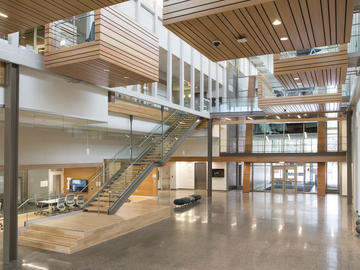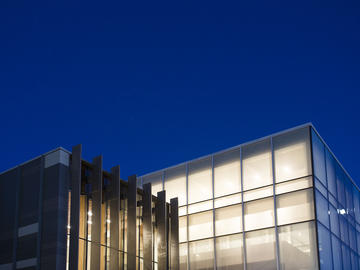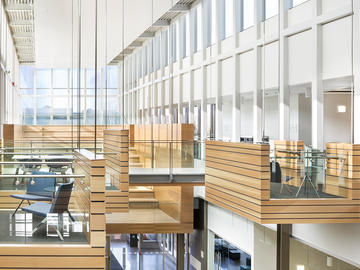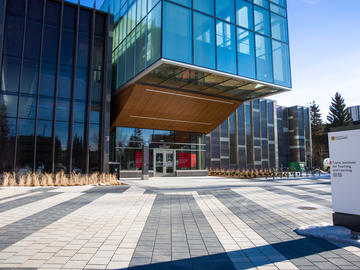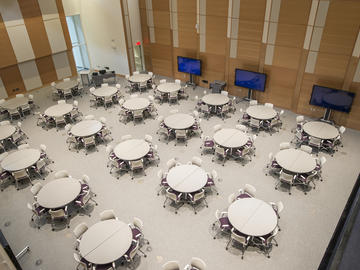The building
The Taylor Institute for Teaching and Learning makes its home in a cutting-edge building at the heart of the University of Calgary’s main campus.
Flexibility, transparency and collaboration
Constructed on the site of the former Nickle Arts Museum, the 40,000-square-foot building was designed by Diamond Schmitt Architects in association with Gibbs Gage Architects. It was modeled according to three guiding principles: flexibility, transparency and collaboration. These three principles are evident throughout the building.
One of a kind establishment for teaching and learning development
The building’s most striking feature is its translucent glass spine, which glows like a beacon at night. The spine projects out over plazas at the east and west doors: 35 feet over the west entrance and 55 feet over the east entrance.
The spine consists of a pair of 220-foot-long, 26-foot-high Vierendeel trusses. The trusses were delivered in twelve sections, with special permits required for the oversized loads. Vierendeel trusses have no diagonal elements, only vertical members connecting the top and bottom chords. This permits unobstructed views from the spine, and allows natural light to pour into the building through clerestory windows.
Inside, the spine forms an atrium, which is the building's main public space. The spine supports a suspended amphitheatre over the west entrance and a boardroom over the east entrance. A series of hanging pods are suspended from the spine’s trusses. Just inside the west entrance is a gallery, which honours the legacy of the Nickle Arts Museum.
The south wall of the atrium is home to the Wall of Honour. The wall celebrates the recipients of teaching awards at the University of Calgary, including the 3M National Teaching Fellowship, the University of Calgary Teaching Awards and the Killam teaching and mentorship awards.

Learning spaces
The building has three flexible learning spaces that encourage instructors to experiment with advanced teaching and learning approaches. On the south side of the atrium, the forum has retractable seating that allows it to convert from a flat-floor learning space to 340-seat public lecture space. Two other learning spaces on the north and east sides of the building feature movable walls that enable subdivision into two or three smaller spaces.
All of the building’s learning spaces are fully flexible, with furniture that can be arranged in different configurations. The spaces are infused with technology and a huge grid of floor boxes. Teaching stations are mobile, giving instructors the option to set up spaces in different ways.
The building’s transparent design – including observation pods outside the learning spaces – ensures that others can observe and learn from this experimentation. The Taylor Institute provides a window to the future of teaching and learning: the discoveries made in the building will inform the design of new learning spaces and new approaches to teaching and learning across campus and beyond.
A green building
The Taylor Institute was also designed to be as sustainable as possible, incorporating a number of features to reduce its impact on the environment.
The attention to sustainability starts right at ground level; the Taylor Institute is built on the foundations of the Nickle Arts Museum. The original intent was to also reuse the steel frame, but it had degraded too far and was ultimately recycled.
During construction
In total, 89 per cent of construction, demolition and land-clearing waste was diverted from landfill for reuse or recycling.
The site’s native soils were preserved through an erosion and sedimentation control plan. Silt fences, silt socks and tire washes were used to keep all the original soil on site during construction.
The building’s finishes incorporate a lot of wood, which adds warmth to the interior space. Preference was given to wood products certified by the Forest Stewardship Council; 99 per cent of the wood used in the building is FSC-certified and sustainably harvested.
Whenever possible, materials with a high-recycled content were used. Recycled materials made up 14 per cent of the total cost of building materials.
Sustainable landscaping
The landscaped areas around the building incorporate trees, shrubs and grasses that are either native to the area or well-adapted to the local climate.
Using drought-tolerant grasses and native vegetation reduces the amount of water needed for irrigation. The choice of plants, combined with an efficient irrigation system, means the building uses 70 per cent less potable water for irrigation compared to a conventional building.
A low-energy building
The Taylor Institute incorporates a number of energy-saving features, including high-performance windows, LED lighting controlled by daylight sensors, low-flow hot water fixtures supplied by a high-efficiency water heater, a well-insulated roof, radiant heating and cooling, and sourcing energy from the campus district energy plant.
The ventilation of the building changes depending on the level of occupancy in certain areas. There are CO2 sensors located throughout the building that ensure sufficient outside air is delivered to the building occupants as needed, and saves energy when areas are unoccupied.
The roof is a light-coloured membrane that reflects more of the sun’s rays and reduces the amount of heat absorbed by the building. This lowers the amount of energy needed to cool the building in summer, and helps to minimize the urban heat island effect.
All of these features combine to reduce the building’s energy use by 71 per cent compared to a conventional building of the same size.


